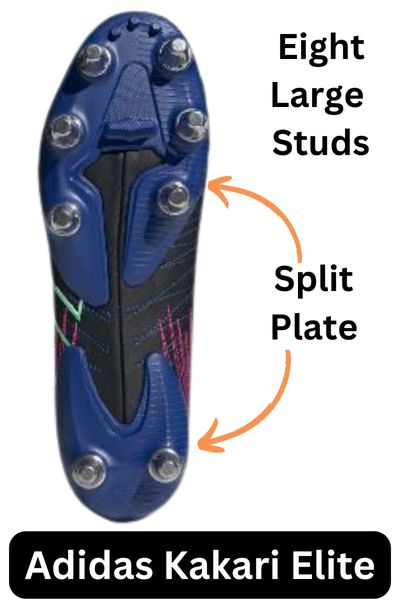If you’re just getting into rugby, you need to know the basics about rugby studs.
There may seem to be a confusing set of different sizes and layouts. But the choice of studs becomes easy when you know what the differences are for.
Why Do Rugby Players Wear Studs?
It’s not mandatory for rugby players to wear studded boots. Referees check studs before a match to be sure that they are safe, but they won’t stop someone from playing if they’re wearing sneakers.
But most professional and amateur players wear studs. When an outdoor sport is played on natural or artificial grass, your feet need extra traction to avoid slipping.
Rugby is played during the wetter months of the year, so studs are even more important.
Take a look at the body positions during a scrum:

If the forwards didn’t wear studs, every scrum on muddy ground would collapse as the players’ feet would slip out from under them.
Scrums and mauls are why forwards tend to wear longer studs than backs.
Both forwards and backs need to sprint, swerve, and sidestep in open play. Again, studs give that extra purchase on the ground.
How Many Studs Are On Rugby Boots?
A rugby boot usually has between six to eight studs.
Here is a typical eight-stud configuration on a popular boot designed for forwards (the Adidas Kakari Elite):

Backs like to have boots that are as light as possible. They wear boots with six studs.
Losing two of the studs may not seem like much. But it makes a difference to the sprinters on the team.
Moulded boots are the exception to this “six or eight” rule. They typically have twelve studs and some can have as many as fifteen.
Different Types Of Studs
Broadly speaking, there are three different types of studs in rugby:
- Metal studs
- Plastic studs
- Moulded studs
Moulded studs are part of the boot plate itself. The underside of the boot is made from one material. This means that moulded studs are not detachable.
Detachable studs
Detachable studs are also known as screw-in studs. Because studs should be fixed in place very tightly, you need a special implement known as a stud key or a stud-tightening tool.
I’d expect a good quality pair of new boots with detachable studs to come with a set of replacements and a stud-tightening tool.
If you go for the cheaper options, you may need to buy these as a separate purchase. That’s a factor we highlighted in our review of the cheapest Adidas Kakari SG boot.
Detachable studs bring two main advantages:
- Replace broken studs without having to replace the boots
- Switch between longer and shorter studs for different types of conditions
Different Stud Sizes
Rugby studs come in several different sizes.
The governing body has a maximum size of 21 mm, but manufacturers can produce any size below that.
In general, longer studs are preferred for soft ground to get extra grip and purchase. As the large brands offer different types of boots, they tend to offer these sizes of studs:
- 8, 10, or 12 mm for six-stud boots
- 15, 18, or 21 mm for eight-stud boots
When you buy a pack of studs, they usually have a mix of either the three shorter lengths or the three longer lengths.
Some players like to have different sizes in their bag for away games. They look at the surface on arrival and choose between e.g. an 18 or 21 mm length for the day.
But many players don’t want to change the length of their studs. We all need spare studs to replace ones that are damaged or even lost during training or matches.
But if you stick to one length, ask around your team-mates to see if you can swap the sizes you don’t use.
Which Is Better: Metal, Plastic, Or Moulded Studs?
The most important factor is the personal preference of players. Some feel more comfortable with one type over the other.
However, both types have different strengths.
Advantages of metal studs
Metal studs are more durable than plastic studs which are prone to wear down over time.
Metal studs won’t last forever with frequent use. But if they’re detachable, players can simply swap in a new set of studs every few seasons.
Forwards playing in wet areas tend to go with metal studs because the fatter and longer versions provide the most traction.

Advantages of plastic studs
But plastic detachable studs also has their own benefits. For a start, they’re cheaper.
But the main advantage of plastic studs is that they are lighter. The “feel” of a boot is important, and many players prefer the lighter and less “boot” feel that plastic studs give to their feet.
Advantages of moulded studs
Moulded studs are plastic but are not detachable from the boot.
The big disadvantage is that you can’t replace the studs when they wear down or get damaged. You have to buy a new pair of boots.
However, they may last longer than detachable studs. When players don’t tighten their screw-in studs properly, they tend to loosen and break before the season is through.
The main advantage of moulded studs is that they provide more traction on firm ground and artificial surfaces.
You’re more likely to see backs wearing them to get that extra purchase when side-stepping through traffic.
Are Rugby Studs Interchangeable?
Rugby studs have traditionally been interchangeable. Different manufacturers and brands have used the same design and thread for screw-in studs.
That means you can buy generic replacement studs or grab studs from one brand of boots to use with your second different brand pair.
Of course, this is better for the consumer. Unfortunately, at least one manufacturer has switched to using a proprietary stud design.
We like the Adidas range of rugby boots, but we don’t like that they’ve locked buyers into their own proprietary studs.
Can You Switch Firm Ground and Soft Ground Studs?

Many rugby players have two pairs of boots, one for firm ground and one for soft ground.
We have a separate article explaining firm vs soft ground rugby boots.
But could you just buy a pair of SG boots and replace the longer studs with shorter FG versions when playing on firm ground?
Yes, you can. But I don’t recommend it with modern quality boots that are designed for FG or SG.
Manufacturers add different design features to allow for comfort and performance on different types of surfaces.
The stud patterns usually have a different layout to provide the best traction for the surface. It’s less than ideal to use the FG layout on soft and muddy ground.
The upper material may be designed to have more “give”. The heel and sole plate may be designed to give more stability on soft ground and more comfort on firm ground.
You’re losing out on the benefits if you mix and match.
Using one pair of boots for different grounds
However, if you’re a casual player or just starting out, then you probably don’t want to invest in two pairs of boots.
Let’s say the season is usually wet but the ground gets dryer in the Spring months.
In that case, then your most cost-efficient path is to buy soft-ground boots for most of the season. You can swap in the shorter FG studs for the last few months on firmer ground.
Are Single Toe Studs Allowed?
In our article comparing rugby boots to American Football cleats, we explained how the American stud configuration tends to have a single toe stud.
This used to be illegal in rugby as it was considered dangerous. However, it’s been legal now for over ten years. I go over the history in that article.
I’ll summarize here by saying that single toe studs are allowed as long as they meet the other stands of maximum length (21 mm).